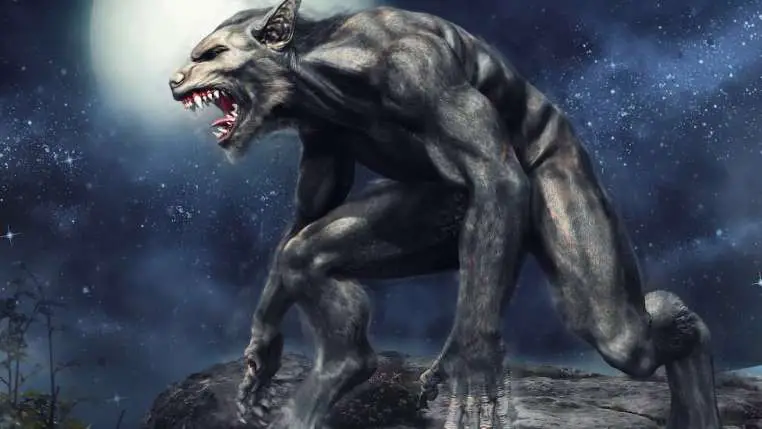Over time, many unexplained events and crimes were attributed to werewolves, with many people firmly believing in their existence.
In Europe, many werewolf myths and legends were born during the 16th and 17th centuries.
Back then, werewolf trials occurred alongside notorious witch trials, resulting in hundreds of innocent people, including women, men, and children, being burned at the stake for being labeled as beast-people.
The notion that a person could transform into a vicious animal was widely accepted, particularly in uneducated and poor communities. In fact, many believed they could make a deal with the Devil to gain such power.
Whether there is any truth behind the werewolf myths and legends remains unknown, but what is certain is that these stories continue to be both fascinating and terrifying.
Werewolf Myths and Legends - The Werewolf of Chalons
One werewolf legend is that of “The Werewolf of Chalons.”
In the early 16th century, a French tailor was condemned for luring, torturing, and killing dozens of young women before cooking and eating them. He was also accused of transforming into a werewolf at night to terrorize the town.
According to records that were kept (as most of the documents were burned), the man confessed to his crimes and made no attempt to justify his actions.
He even swore to return from the dead and devour anyone who witnessed his public execution. The trial was short, and the judges sentenced the tailor to be burned at the stake.
The sentence was carried out the next day.
The execution was reportedly a terrifying event, with the killer struggling with an unseen strength and hurling curses and blasphemy at the crowd.
For some unknown reason, all the official documents of the trial were destroyed, leaving us with no definitive account of what really happened on that day.
Peter Stubbe, the Serial Killer Werewolf
Among the most terrifying werewolf myths and legends is the one of Peter Stubbe, who openly claimed to be a bloodthirsty werewolf.
In 1589, Stubbe claimed that his wolf-skin belt allowed him to transform into a beast, making him unable to control his animalistic impulses.
He allegedly killed and consumed around 12 victims.
Stubbe believed that the Devil himself had given him the cursed belt, turning him into a bloodthirsty wolf with glowing eyes, a large body, sharp teeth, and strong paws.
Peter Stubbe was imprisoned, tortured, and beheaded on Halloween 1589, and his body was burned at the stake and his ashes scattered.
The Wolf of Ansbach
In 1685, the small town of Ansbach in Bavaria, Germany, was disturbed by a series of terrifying events.
Numerous domestic animals, including horses, sheep, goats, and cows, were found killed and partially devoured, with some missing only their hearts.
The events culminated in the unexpected death of the town’s mayor, who was found dead on a nearby field covered in blood but with no signs of violence.
The frightened locals suspected the mayor of being a werewolf responsible for the dead animals, and local hunters eventually killed a wolf. The hunters dressed the mayor’s corpse in the wolf’s fur, carried it through the streets for three days, and then burned the body and buried the ashes.
The mysterious attacks subsequently stopped.
Werewolf Myths and Legends - The Legend of Hans 'the Werewolf'
In the 17th century, several werewolf trials were held in Estonia, including that of Hans “the Werewolf.”
At that time, people were accused of making deals with the Devil to gain the power to transform into beasts. Most of the accused confessed to their crimes after brutal torture, but Hans, an 18-year-old youth, claimed that his curse was due to being bitten by a mysterious “man in black.”
Interestingly, Hans’ testimony is one of the first documented in history to suggest that “the werewolf’s curse” could be transmitted through a bite.
Eventually, Hans confessed to hunting and killing people as a werewolf for almost two years.
The tribunal found him guilty of witchcraft, and the young man was executed.
To this day, the story of Hans “the Werewolf” remains one of the most well-known werewolf myths and legends.
The Werewolf of Dole: A Chilling Tale from French Lore
The French are known for their fascination with werewolf myths and legends, and one of the most famous cases is that of the “Werewolf of Dole.”
Dole, a small town in France near the Swiss border, was once plagued by a terrifying event.
In the early 1400s, nearly 20 children disappeared, and their remains were found scattered throughout the town. The villagers, convinced that a supernatural creature committed the crimes, began a hunt for the werewolf.
Gilles Garnier, a hermit living on the outskirts of Dole, quickly became the prime suspect in the children’s slayings.
When the villagers searched his home, they found tools used to hack his victims, as well as human remains buried nearby.
Garnier claimed that a demon had given him a potion that allowed him to transform into a beast, half man, and half wolf. He confessed to only four murders, but this was enough to enrage the villagers, who burned him at the stake.
The Case of Jacques Roulet: Another French Werewolf Legend
Another infamous French werewolf legend is that of Jacques Roulet.
The discovery of a mutilated boy’s body in the woods near Caude caused panic among the local population. A few feets away from the body, hiding in a bush, the locals found Roulet, a young man from the village who was already suspected of practicing witchcraft.
Wounded and naked, Roulet immediately confessed to the murder of the boy and the others. Like Garnier, Roulet claimed to have a potion that turned him into a wolf.
However, he was not executed for his crimes but instead declared insane and interned in an asylum.
The Disturbing Tale of Pierre Burgot and Michel Verdun
One of the most disturbing werewolf myths and legends is the story of Pierre Burgot and Michel Verdun, two friends who, in 1521, murdered and consumed several women and children.
Apparently, they loved hunting together, pursuing and stalking their victims for days.
During their trial, they admitted to being werewolves and taking pleasure in killing and eating their victims. Their crimes were heinous, including the savage killing of a woman, the abduction and mutilation of a 4-year-old girl, desecrating graves, and cannibalism.
Burgot and Verdun were also accused of making a pact with the Devil after they confessed to bathing in the blood of their victims.
They were both beheaded, and their bodies were burned.
Werewolf Myths and Legends - The Terrible Tale of Emily Isabella Burt
A frightening werewolf legend hails from Georgia, United States.
In the mid-nineteenth century, Mildred Burt, a widow, lived in a remote rural area with her daughter, Emily Isabella Burt.
Emily suffered from severe sleep disorders and had a rare disease, lycanthropy, which caused her body to be covered with thick hair and her canines to grow unusually long.
When a neighbor, William Gorman, reported that an unknown animal had killed several of his sheep, Mildred feared that Emily might be responsible.
One night, Mildred took a gun and went to investigate the pens where the attacks took place. She was attacked by a mysterious beast that bit her hands and feet, but she managed to fire a shot, injuring the beast, which then disappeared.
When Mildred returned home, she found blood and mud tracks leading to Emily’s room, where she found her daughter lying on the floor, covered in blood, with a gunshot wound to her arm.
Emily was sent to Paris for treatment and died in a psychiatric hospital in 1911.
The nocturnal attacks ceased immediately after.
Vseslav of Polotsk: A Werewolf Ruler
Vseslav of Polotsk (c. 1039-1101) was a legendary figure widely regarded as the most renowned leader of the Polotsk principality and, for a brief period, served as the Grand Prince of Kyiv (1068-1069).
He is widely remembered for his accomplishments, including for finalizing the construction of the Saint Sophia Cathedral in Polotsk, which remains one of the oldest monuments in present-day Belarus.
However, despite his many achievements, Vseslav’s rule was controversial. He was known as Vseslav the “Wizard” due to his rumored ability to transform into a wolf.
The folklore surrounding Vseslav suggests that on the eve of significant battles, he would turn into a beast and terrorize his enemies, inspiring so much fear that invading soldiers would desert rather than face him in battle.
These werewolf myths and legends surrounding Vseslav solidified his legacy, cementing his place in history as a ruler who wielded supernatural powers.
He died on April 24th, 1101, and was buried in the Saint Sophia Cathedral in Polotsk.
In 2005, the Belarusian government honored his memory by issuing a commemorative coin featuring his portrait with a wolf visible in the background.
The Beast of Gevaudan: A Terrifying Legend
The legend of the Beast of Gevaudan is one of the best-documented werewolf incidents in history.
Between 1764 and 1767, the town of Gevaudan in France was terrorized by a mysterious creature that claimed the lives of over 100 people.
The beast, which witnesses reported as having impressive dimensions, indiscriminately attacked women, children, and men, leaving no fewer than 16 victims completely decapitated.
In response to the threat, King Louis XV offered a substantial reward for the capture or killing of the beast, and no fewer than 20,000 experienced soldiers and hunters were deployed to track down the monster.
Despite these efforts, opinions varied as to the nature of the beast, with some people believing it was an unusually large wolf. In contrast, others rejected this theory and instead attributed the killings to a werewolf.
Today, modern scholars are divided on the matter, with some being skeptical of the wolf theory and proposing alternative hypotheses, including the possibility that the Beast of Gevaudan was, in fact, a werewolf.
Werewolf Myths and Legends in Ancient Greece
The concept of lycanthropy is not recent, with reports of “werewolf sickness” dating back to Ancient Greece, where the werewolf legend first emerged.
In Greek mythology, it was believed that a person could turn into a beast if they consumed an assortment of human flesh, wolf flesh, and various magical plants and extracts.
This belief was the basis for the legend of King Lycaon, who attempted to deceive Zeus into eating human flesh.
In punishment for his deception, Zeus transformed him into a wolf, solidifying his place in history as the first recorded werewolf in Western mythology.
At Ancient Theory we only use trusted sources to document our articles. Such relevant sources include authentic documents, newspaper and magazine articles, established authors, or reputable websites.
- Werewolf Legends from Around the World. history.com. [Source]
- Stevenson Davis - Walk-Through of 11 Werewolf Legends and Myths Around the World. dreame.com
- Charlotte F. Otten - The Lycanthropy Reader: Werewolves in Western Culture. Syracuse, 1986.
- Werewolf Legends. history.com. [Source]
- Sabine Baring-Gould - The Book of Werewolves: Being an Account of a Terrible Superstition. Smith, Elder & Co, London, 1865.
- Werewolf legends around the world: The legend of lycanthropy. vocal.media.
- Adam Douglas - The Beast Within: A History of the Werewolf. Chapmans, London, 1992.






